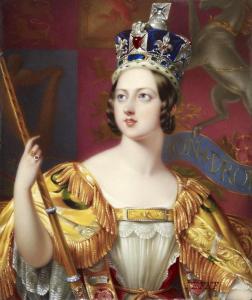Today, I’m going to answer a question that I’ve been asked a surprising number of times: did Victoria prevent the criminalization of lesbianism because she didn’t believe that lesbians existed?
According to the myth, the Criminal Law Amendment Act 1885 originally contained provisions criminalizing homosexual activity between women as well as men, but Victoria refused to sign the bill until the provisions relating to women were removed, arguing that “women do not do such things.”

Victoria in her coronation robes, as painted by Sir George Hayter. Image courtesy of Wikimedia Commons.
From a constitutional standpoint, the story is impossible. It seems to assume that the British monarch had a line-item veto similar to that found in the US, but this has never been the case. Not even Henry VIII could cherry-pick provisions from a bill and veto them—legislation must be approved or rejected in toto. In fact, the Sovereign doesn’t even see the final text of a bill. Instead, the Lord Chancellor submits the necessary Letters Patent accompanied by a list of all the bills that have completed their parliamentary journey.
In theory, Victoria could have vetoed the entire bill, but no Sovereign has done that since Anne vetoed the Scottish Militia Bill in 1707. Victoria may have tested the bounds of constitutional propriety from time to time, but blocking legislation passed by Parliament would have been a step too far.
The Criminal Law Amendment Act didn’t mention homosexual activity at all until a Liberal MP named Henry Labouchère successfully moved an amendment to the bill. It allowed the courts to punish ‘gross indecency’ between two men with a prison sentence of up to a year, with or without hard labor. A glance at Hansard reveals that lesbian activity was never part of Labouchère’s amendment, so there would have been no provisions for Victoria to object to.[1]
Needless to say, this myth is busted.
NOTE
[1] The text can be found at HC Deb, 6 August 1885, col. 1397.

Though the story remains that Victoria did not believe women did such things. Do you accept that?
Unfortunately, I’m not aware of Victoria taking a stand one way or the other on the subject.
Queen Victoria was perfectly capable of rejecting a Bill she didn’t like – and could easily refuse to sign such an Act. And the P.M. would certainly not make a fuss, just squash the clause at birth. And not being aware that Victoruia took a stand is not the same as being aware that Victoria did not take a stand – not that she would have had to stand up – just sit there and say, “No way, José” or the contemporary equivalent.
The British monarch’s power to veto legislation hasn’t been used since the early 18th century; if Queen Victoria had threatened to veto a bill, it would have provoked a constitutional crisis. We know that Victoria signed legislation that she disliked (e.g., the Irish Church Act 1869), so the notion of a royal veto threat is implausible.
Furthermore, we can see from Hansard that Henry Labouchere’s amendment never mentioned lesbian acts (MPs only made one change to the amendment, and that was to increase the maximum penalty from one year of imprisonment to two). There’s no evidence that he changed his amendment under pressure from the Government, and since Labouchere was a backbench opposition MP with radical views, it’s highly unlikely that he was taking cues from Victoria, either.
Those British got it easy. Here in Victoria, Australia, the sentence for buggery until 1949 or so was hanging.
Until 1861, buggery was a capital offense in Britain as well.
But no hangings took place after about 1834.